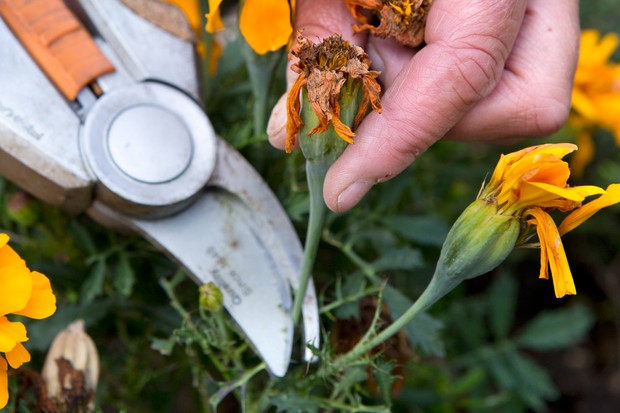
The purpose of flowers is to enable plants to reproduce, so gardeners are the lucky beneficiaries, using their colourful blooms to create vibrant displays.
But as flowers fade, the plant’s energy is devoted to producing seeds. This reduces its vigour and may even signal the beginning of the end for annuals and summer bedding.
Picking off flowers as they fade – or deadheading – isn’t the most complicated of gardening tasks, but it can be time-consuming if you have lots of containers or a large plot. Still, if you make the time to do it little and often, your efforts will be repaid as it will keep the show going so you can have colour right through to the first frosts.
More advice on how to deadhead:
To keep you motivated, here are six reasons why deadheading is important.
1
Keep plants looking their best
Deadheading tagetes
Using scissors or secateurs, pick over containers and garden plants several times a week to prevent faded flowers spoiling the display. Undertaken in the cool of the evening, it’s an opportunity to reconnect with your plants before you stand back and admire the results.
2
Extend the display

Deadheading zinnias with secateurs
Pick off flowers to control flower production and time displays so they’re at their best for a particular date. Deadhead summer bedding, such as zinnias, before you go on holiday – this will avoid dead flowers rotting while you’re away, and you’ll come home to fresh blooms.
3
Prevent damage to leaves

Deadheading petunia flowers
Remove fading flowers from petunias, pelargoniums and busy Lizzies before the petals fall onto the foliage. Wet petals stick to leaves and can cause rotting that leads to unsightly brown patches. Gently shake plants so that loose petals fall away from the leaves.
4
Remove flowers before they seed

Removing sweet pea pods
Pollinated flowers develop seeds of fruit as soon as their petals fall, diverting the plant’s energy from making more flowers. Sweet peas, in particular, are quick to form pods. Keep cutting the flowers for the house, or remove all the dead flowers promptly.
5
Channel energy into bulbs

Deadheading a lily
Bulbous perennials such as lilies need a chance to replenish their bulbs if they’re to produce a good display of flowers next year. Putting their energy into forming seeds after flowering won’t help this process, so cut off flower heads once their petals fall.
6
Control self-seeding plants

Field poppy
After flowering, many plants produce seeds in abundance. If allowed to fall, these can result in seedlings you may not want. Enthusiastic self-seeders include hellebores, lady’s mantle, aquilegias and poppies. Snip off seedheads before they ripen and release their contents.
